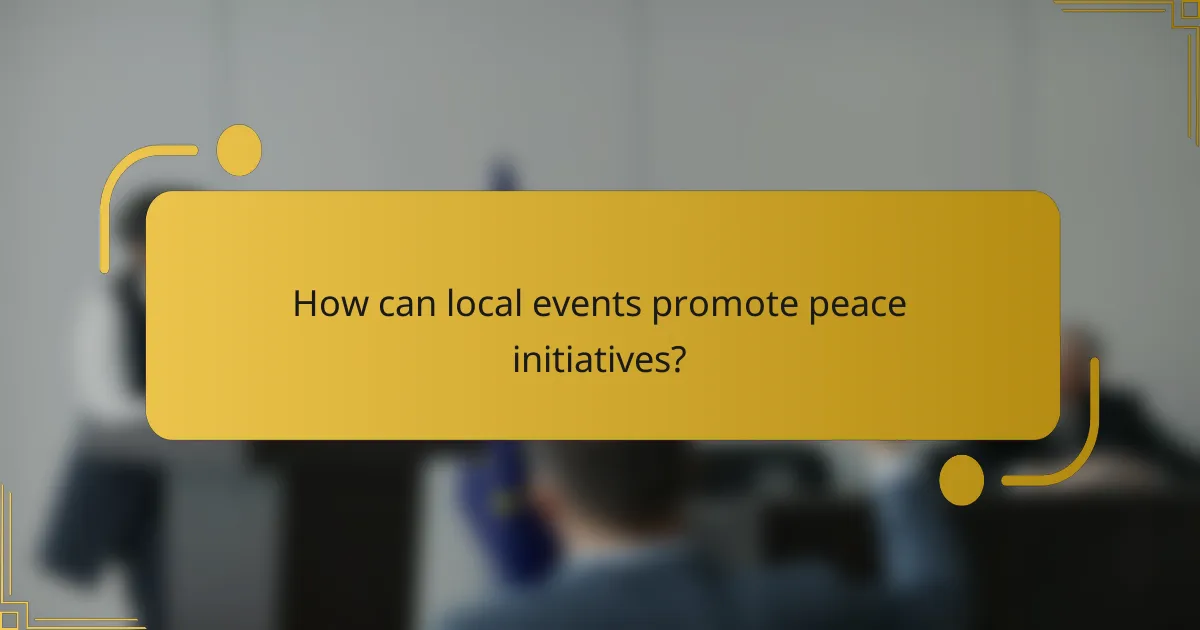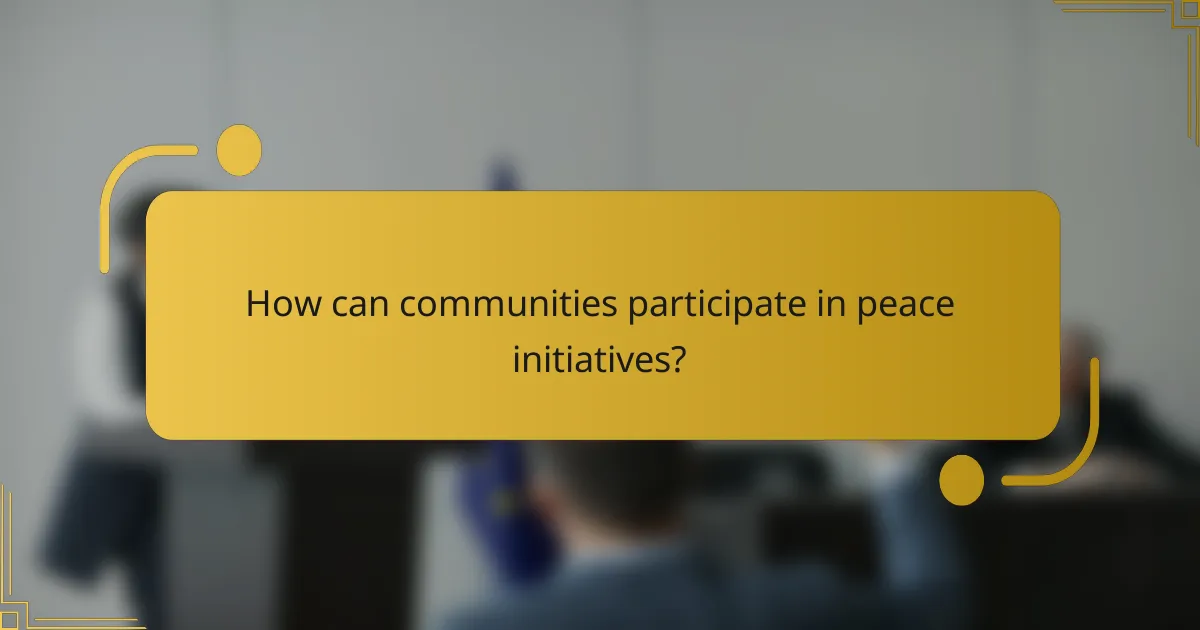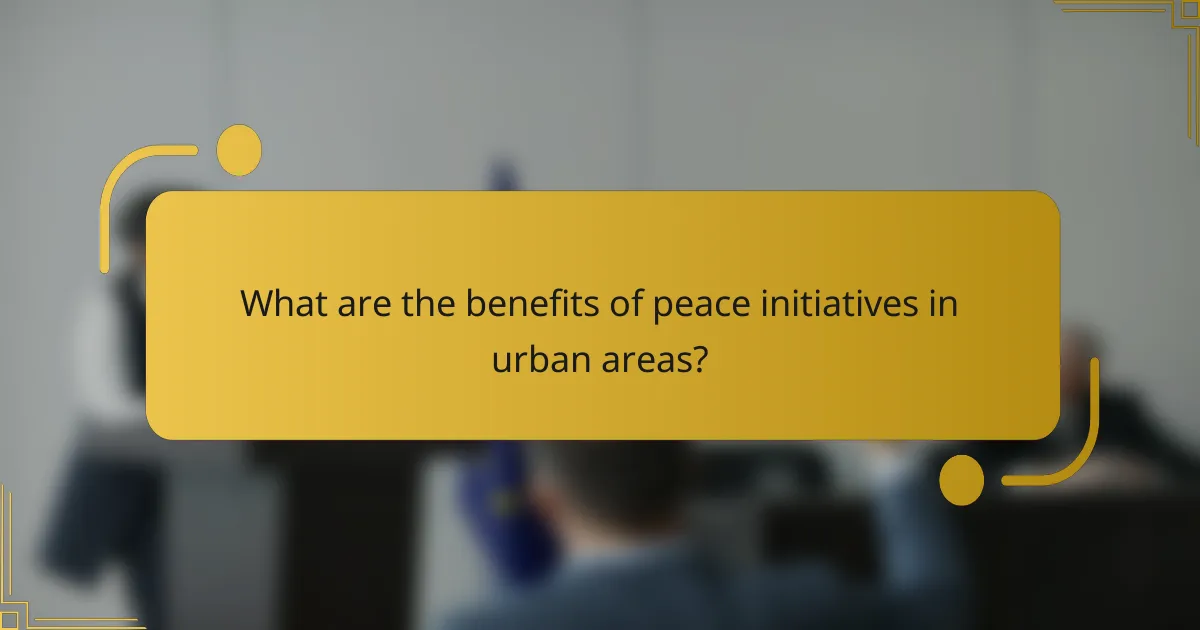Peace initiatives thrive on local events and awareness campaigns that engage communities and promote understanding. By fostering connections and encouraging collaboration, these efforts empower individuals to participate actively in conflict resolution and harmony-building. Through various activities, communities can come together to raise awareness, share experiences, and work towards sustainable peace.

How can local events promote peace initiatives?
Local events can significantly enhance peace initiatives by fostering community engagement and raising awareness about conflict resolution. They create opportunities for individuals to connect, share experiences, and collaborate on solutions that promote harmony within their neighborhoods.
Community festivals
Community festivals serve as vibrant platforms for promoting peace initiatives by bringing together diverse groups. These events often feature cultural performances, food stalls, and activities that celebrate local traditions, allowing participants to appreciate different backgrounds and foster mutual respect.
To maximize their impact, organizers should include workshops or booths focused on peace education, conflict resolution, and community resources. Engaging local leaders and artists can also enhance the festival’s appeal and reach.
Workshops and seminars
Workshops and seminars focused on peace initiatives provide structured environments for learning and dialogue. These sessions can cover topics such as conflict resolution techniques, effective communication, and community building strategies.
When planning these events, consider incorporating interactive elements like role-playing or group discussions to encourage participation. Collaborating with local experts or organizations can also lend credibility and attract a wider audience.
Peace marches
Peace marches are powerful visual statements that can unite communities around shared values of non-violence and solidarity. These events often draw attention to specific issues, such as social justice or human rights, and can inspire collective action.
To organize a successful peace march, ensure clear messaging and a defined route that highlights significant local landmarks. Engaging local media can amplify the event’s visibility, while partnerships with community organizations can enhance turnout and support.
Interfaith dialogues
Interfaith dialogues promote understanding and cooperation among different religious groups, which is essential for fostering peace. These discussions encourage participants to share their beliefs and values, helping to break down stereotypes and build trust.
To facilitate effective interfaith dialogues, create a safe and respectful environment where all voices are heard. Consider using trained facilitators to guide conversations and focus on common goals, such as community service projects or joint advocacy efforts.

What awareness campaigns are effective for peace?
Effective awareness campaigns for peace focus on engaging communities through relatable messaging and accessible platforms. They aim to foster understanding, promote dialogue, and encourage active participation in peace-building efforts.
Social media campaigns
Social media campaigns leverage platforms like Facebook, Twitter, and Instagram to spread messages of peace quickly and widely. These campaigns can include hashtags, shareable graphics, and videos that resonate with audiences, encouraging them to engage with the content and share it within their networks.
To maximize impact, campaigns should target specific demographics and use analytics to track engagement. For example, a campaign might focus on youth, using popular influencers to amplify the message and encourage participation in local peace initiatives.
Public service announcements
Public service announcements (PSAs) are short messages designed to inform the public about peace initiatives and encourage community involvement. These can be broadcast on television, radio, or displayed in public spaces, ensuring they reach a broad audience.
Effective PSAs often include a clear call to action, such as attending community meetings or participating in local events. They should be concise and impactful, using emotional appeals or storytelling to connect with viewers and listeners.
School outreach programs
School outreach programs aim to educate students about the importance of peace and conflict resolution. These programs can include workshops, interactive sessions, and collaborative projects that encourage students to think critically about peace and their role in fostering it.
Incorporating activities like role-playing or community service projects can enhance engagement. Schools can partner with local organizations to provide resources and support, ensuring that students not only learn about peace but also practice it in their daily lives.

How can communities participate in peace initiatives?
Communities can engage in peace initiatives through various activities that promote awareness, collaboration, and action. Participation can take many forms, including volunteering, joining advocacy groups, and forming partnerships with non-governmental organizations (NGOs).
Volunteer opportunities
Volunteering is a direct way for community members to contribute to peace initiatives. Local organizations often seek volunteers for events such as peace marches, educational workshops, and community dialogues. Engaging in these activities not only helps the cause but also fosters a sense of belonging and purpose.
To find volunteer opportunities, check local community boards, social media groups, or websites dedicated to civic engagement. Many organizations offer flexible schedules, making it easier for individuals to participate while balancing other commitments.
Local advocacy groups
Joining local advocacy groups is another effective method for community participation in peace initiatives. These groups often focus on specific issues such as conflict resolution, social justice, or human rights, providing a platform for collective action. Members can engage in campaigns, attend meetings, and contribute to policy discussions.
Research local advocacy organizations to identify those that align with your values. Participating in their events or initiatives can amplify your voice and help drive change within the community.
Partnerships with NGOs
Forming partnerships with NGOs can enhance the impact of community peace initiatives. NGOs often have resources, expertise, and networks that can support local efforts. Collaborating with these organizations can lead to joint projects, funding opportunities, and increased visibility for community initiatives.
To establish partnerships, reach out to NGOs that focus on peacebuilding and community development. Propose specific projects or initiatives where both parties can contribute, ensuring that the partnership is mutually beneficial and aligned with shared goals.

What are the benefits of peace initiatives in urban areas?
Peace initiatives in urban areas foster social cohesion, enhance community well-being, and promote sustainable development. These programs can lead to stronger relationships among residents, increased participation in civic activities, and improved safety in neighborhoods.
Improved community relations
Peace initiatives help build trust and understanding among diverse community members. By organizing events that encourage dialogue and collaboration, residents can address common issues and celebrate their shared values.
For example, community festivals or workshops can bring together people from different backgrounds, fostering friendships and reducing tensions. This improved rapport can lead to a more harmonious living environment.
Increased civic engagement
When peace initiatives are implemented, they often inspire residents to become more involved in local governance and community projects. Increased civic engagement can manifest through participation in town hall meetings, volunteering for local organizations, or joining neighborhood watch programs.
Encouraging residents to take an active role in their community can lead to better decision-making and a stronger sense of ownership over local issues. This engagement is vital for creating a responsive and accountable local government.
Enhanced public safety
Peace initiatives contribute to enhanced public safety by fostering a sense of community vigilance and cooperation. When residents are engaged and connected, they are more likely to look out for one another and report suspicious activities.
Programs that promote neighborhood watch schemes or community policing can significantly reduce crime rates. For instance, areas with active community involvement often see lower levels of vandalism and violence, creating a safer environment for all residents.

What criteria should be considered for organizing peace events?
When organizing peace events, it’s essential to consider factors such as the target audience, the event location, and the overall objectives. These criteria help ensure that the event effectively promotes peace and engages the community.
Target audience
Identifying the target audience is crucial for the success of peace events. This could include local community members, youth, educators, or specific interest groups. Tailoring the message and activities to resonate with the audience increases participation and impact.
For example, if the event aims to engage youth, incorporating interactive workshops or music can be effective. Conversely, if the audience consists of local leaders, discussions on policy and community initiatives may be more appropriate.
Event location
The location of a peace event significantly influences attendance and engagement. Choosing a venue that is accessible and familiar to the target audience can enhance participation. Consider community centers, parks, or schools as potential venues.
Additionally, ensure the location is equipped to handle the expected number of attendees and has necessary facilities, such as restrooms and seating. Outdoor venues may require contingency plans for weather, while indoor spaces should comply with local safety regulations.


